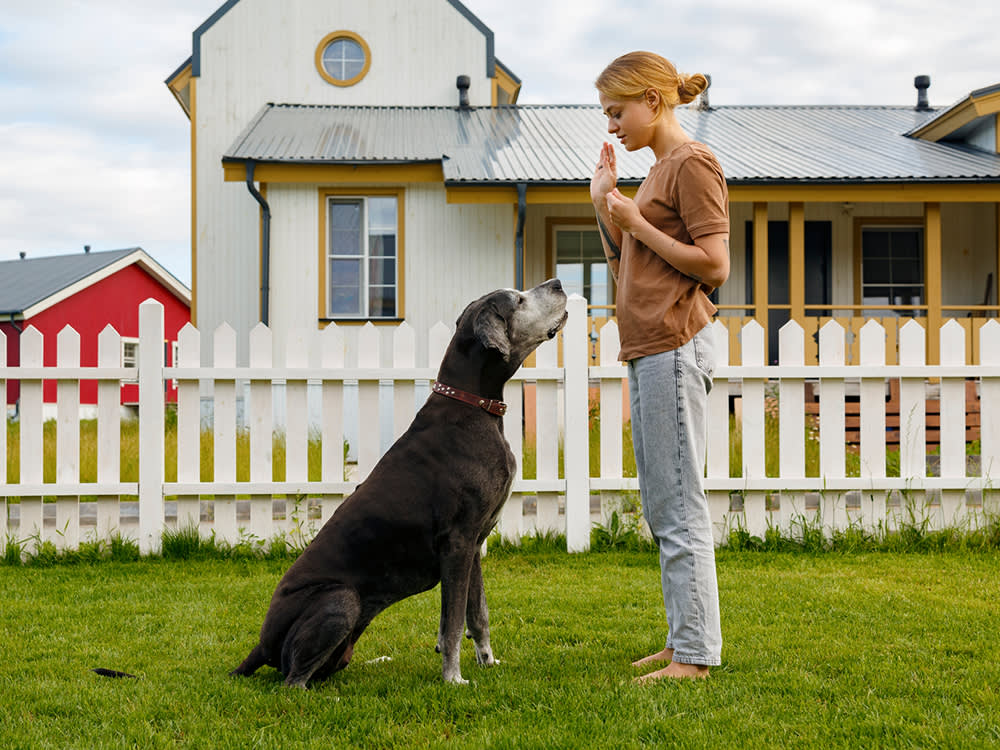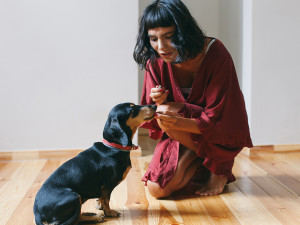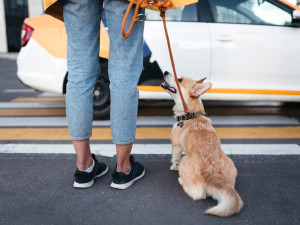Are Friends and Family Derailing Your Dog’s Training?
What to do when your best-laid training plans are sabotaged.

Share Article
Training a dog is hard work, and sometimes, it feels like there’s an army of folks conspiring against you, determined to derail your efforts. Maybe your dad loves to roughhouse with your dog, or your best friend encourages your dog to jump up on her every time she visits. It could be that your dog sitter forgets to give your dog a treat if they come when called, or your niece thinks it’s funny to chase your dog when they steal a sock and run away.
Out of necessity, I have developed defensive strategies to prevent other people from wrecking both my own and my clients’ best-laid training plans — because the last thing you want is for your dog to lose the association between a cue you’ve taught them and the desired behavior. Here’s how to prevent other people from putting a wrench in your hard work.

littleKin™ is Kinship’s home just for puppy and kitten parents. Bop over to check out expert advice, new pet tools, and special deals—all curated for your newest family member.
opens in a new tabHow to Know If a Cue Has Been Poisoned
It takes a lot of consistent work over many months to teach a dog a totally reliable recall — to come when called every single time. I like to think that for a well-trained dog, the cue “come!” means “Whatever I’ve got here, she’s got something better over there.” In actual practice, that level of perfection — the dog always receives something so wonderful that they are glad they came when called — is hard to achieve, but the goal is to be as close as possible.
Many of us achieve a good recall with cues we don’t intentionally use. For example, lots of dogs come every time they hear the crinkle of a bag of treatsopens in a new tab or see us pick up the leashopens in a new tab. To most dogs, those actions are linked with getting treats and going for a walk because of the exceptionally strong association between the cue and what follows.
From the dog’s point of view, the spoken command “Come!” rarely predicts something so reliably great. This is partly because we’re up against other people who call our dogs-in-training to come and don’t reinforce them when they do so. Luckily, you can usually swamp these occasional “oops” moments with plenty of better experiences.
The real recall-killer, however, is calling a dog to come and then doing something that is aversive rather than reinforcing. When a dog isn’t sure if offering the behavior in response to a cue will lead to something good or to something bad, the cue has been poisoned, and the dog will resist responding to it. So, if a dog runs to a groomer who called them to “come” and then clips their nails and gives them a bath — both of which he hates — the cue is being poisoned. The aversive can be something obviously bad (being yelled at) as well as something less obviously negative (the end of playtime).
A cue is rarely poisoned by just one or even a few misuses, but repeated bad experiences are a different story. Because it’s difficult to fix a poisoned cue, your best bet is to change it. Yes, it’s possible to reverse the dog’s negative association with a cue, but it’s less work to build a new association. For example, “Here!” or “This way!” are good alternatives to “come.”
Teaching a New Response
Years ago, I lived in an old farmhouse while it was being renovated, so workers were in the house with my dog, Bugsy, while I was at work. I knew and trusted these men, so I wasn’t worried about Bugsy’s safety and well being. In fact, the men loved my dog so much that their enthusiasm became a problem.
Each time they arrived, there were effusive greetings all around, which included encouraging Bugsy to jump up on them. Bugsy was a big dog and the men got a kick out of how they could get his front paws on the their chests. The problem was that I didn’t want my dog’s front paws on anybody’s chest. In fact, after I adopted Bugsy, I spent months “de-jumping” him — teaching him not to jump up like that.
A week into the remodel, I came home to a dog who jumped on me with great joy and enthusiasm. Though I was, of course, pleased to see Bugsy, the joy and enthusiasm were all his. I was totally joyless and unenthusiastic about the return of this behavior; among other things, I was concerned about him knocking over a child or my frail elderly neighbor, or upsetting people who like to keep their clothes free of dog prints.
Also, as a professional dog trainer who referred to Bugsy as “the best r�ésumé I’ve ever had,” I saw a lot of awkwardness in my future. If he jumped on people during public appearances or when I was using him as a demonstration dog in group classes, I was going to look foolish. Immediate action was necessary. My first strategy — asking the guys not to encourage Bugsy to jump up on them and explaining the reasons why — had no effect.
After observing that the men patted their chests to encourage Bugsy, I came up with a solution. I taught Bugsy to sit whenever people patted their chests. In other words, I wrecked the workers’ ability to invite Bugsy to jump up by making that action a cue to sit. After a few weeks, my efforts paid off. A fellow who had just started working with the crew told me that he tried to get my dog to jump up, patting his chest as he told me this, but that the silly mutt couldn’t seem to figure it out. He actually implied that maybe my dog was stupid because he sat instead. (It’s not my dog who can’t figure out what’s going on, I thought, with considerable satisfaction.)
To prevent the workers from finding another way to invite Bugsy to jump up, I showed them how to cue Bugsy to shake, wave, or high-five. Luckily, the guys found these tricks more entertaining than having Bugsy put his paws on their chests, so I didn’t have further problems.
Creating Unique Cues
When it comes to a defensive strategy, choosing atypical cues has an upside. If your cues are standard (“sit,” “heel,” “down,” “come”) and you use “okay” as a release for “stay” and “leave it,” then your dog is more vulnerable to training sabotage from other people. Someone can poison the cue or make it irrelevant by saying it endlessly even when the dog is clearly not going to respond. This often happens with “come” and also with “drop it,” which many people say to a dog who is holding something in their mouth. The result is that the dog learns that those sounds are meaningless, making it harder to teach them to respond appropriately in the future.
If you use unusual cues, or words in a foreign language, you protect yourself and your dog from these problems. How likely are most of us to come across people who try to communicate with our dogs using the Dutch “af,” meaning “down,” the French “ici” for “come” or the Czech “zustan” for “stay?” Avoiding the release word “okay” in favor of the less-common “free” or even a random choice such as “jailbreak!” or “all done” prevents interference from other people.
Staying Proactive
Specific defensive strategies are useful, but none are as effective as taking charge of the situation and doing everything you can to be assertive about what happens around your dog. Few people are skilled in dog training, but for the most part, they mean no harm. (If someone is purposely wrecking your dog’s training, they don’t deserve to be around either of you.) Most people will do the right thing with some direction, and that can prevent them from causing training trouble.
So, manage the situation. That may mean preventing access to your dog, especially in your absence. It can also mean saying in a straightforward way, “He came when he was called, so give him this stuffed Kong,” as you hand it over.
If someone is encouraging your dog to steal things and play keep-away, tell them exactly what to do instead, and why: “This will teach them to make a game of stealing things, and I don’t want that. Instead, let’s encourage them to trade that sock for a handful of treats.”
If someone is playing rough with your dog, tell them, “They’re not allowed to play that way because they get too excited and start biting, but here’s a tug toy that they will like playing with even more.” If that fails to change the person’s behavior, you can intervene by enticing your dog into a game of tug with you, or by saying, “When they gets overly aroused like this, I put them in their crate with something to chew on so they can calm down,” and then do exactly that.
Dog training would be tricky enough if you could do it in a bubble with no interference from anyone else. As it happens, you do it in the real world where all kinds of unplanned challenges crop up. As frustrating as this can be, there are ways to counteract the actions of these would-be spoilers. Ultimately, you’re responsible for training your dog and protecting them from setbacks — any way you can.

Karen B. London, PhD, CAAB, CPDT-KA
Karen B. London, Ph.D., is a Certified Applied Animal Behaviorist and Certified Professional Dog Trainer who specializes in working with dogs with serious behavioral issues, including aggression, and has also trained other animals including cats, birds, snakes, and insects. She writes the animal column for the Arizona Daily Sun and is an Adjunct Professor in the Department of Biological Sciences at Northern Arizona University. She is the author of six books about training and behavior, including her most recent, Treat Everyone Like a Dog: How a Dog Trainer’s World View Can Improve Your Lifeopens in a new tab.

